
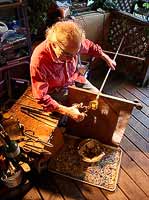
Next, we'll move into the process of creating the blown glass planets and Sun. The planets are supported by curved, hollow carbon fiber arms; the longest being 3 feet (1m), so the orbs must be very light. Just as in the Celestial Winds Blown Glass and Carbon Fiber Mobiles that we make, that have arms as long as 20 feet (6m), saving every ounce of mass that is way out on the end is very important. You're probably asking why we choose to pay that mass penalty when plastic could be used instead. Answer is simple:
“There's nothing quite like glass.”™In fact, it's our tag line on GlassSculpture.org. Now, you might think that making planets out of glass is a relatively simple task. Deceptively difficult is what it is. The glass blowing process requires a lot of planning and strict adherence to a sequence of steps that have been refined over time in order to arrive at a successful result.
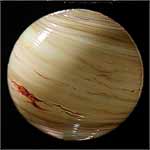 Here are the required parameters:
Here are the required parameters:
- Must look like the planet it represents. (otherwise, what's the point?)
- Must be the correct relative size. (exact scale is NOT possible, so relative scale is used)
- Must be extremely low in mass. (wall thickness must be very thin)
 We begin with a small gather; approximately 1" (25.4mm) of 2,200°F (1,204°C) molten crystal on the end of a blowpipe. Then colored glass in various gauged sizes is applied to the surface and melted in to make the base color of the planet. This glass is called "frit". It ranges in 5 steps from .25" (6.4mm) chunks down to fine powder and we can never have enough color and size selection. Gets to be very expensive.
We begin with a small gather; approximately 1" (25.4mm) of 2,200°F (1,204°C) molten crystal on the end of a blowpipe. Then colored glass in various gauged sizes is applied to the surface and melted in to make the base color of the planet. This glass is called "frit". It ranges in 5 steps from .25" (6.4mm) chunks down to fine powder and we can never have enough color and size selection. Gets to be very expensive.
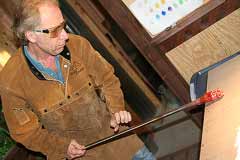 Sometimes, as in the case of Mars, larger frit of slightly different colors is applied along with the base color powder to create variegations in the surface value and texture.
Sometimes, as in the case of Mars, larger frit of slightly different colors is applied along with the base color powder to create variegations in the surface value and texture.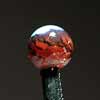 Then, different types of white glass are applied to form cloud patterns and polar caps. Some may be applied directly to the base color surface and some may be applied to what is called an "over-gather" of clear crystal. When applying the color the glass is pretty gooey, so it becomes misshapen and must be reshaped; usually on the marver—the large stainless plate seen above.
Then, different types of white glass are applied to form cloud patterns and polar caps. Some may be applied directly to the base color surface and some may be applied to what is called an "over-gather" of clear crystal. When applying the color the glass is pretty gooey, so it becomes misshapen and must be reshaped; usually on the marver—the large stainless plate seen above.

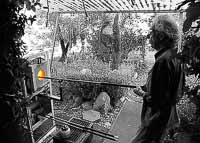 After each application of color, the glass has cooled so it is reheated in what is called a "Glory Hole" an auxiliary furnace for reheating glass that has cooled during offhand blowing. Managing heat is the greatest challenge in glass blowing. Get your heat right and everything goes they way you want. Get it wrong and you're in for a bad time. Heating one portion, while allowing another to cool by only a few tens of degrees can bring dramatic results. Knowing where in the furnace the hottest spots are and where those spots drop off is invaluable in making this happen to your advantage.
Once the decoration phase is complete, the blowing out of the sphere is done. The decoration must be applied to the small "plug" in such a way that it all will migrate and end up where it is supposed to when the sphere has finished expanding; some four times its original diameter—or in some cases more. That is where the trial and error comes in. Lots of trial. Lots of error; with some successes thrown in to keep you interested.
After each application of color, the glass has cooled so it is reheated in what is called a "Glory Hole" an auxiliary furnace for reheating glass that has cooled during offhand blowing. Managing heat is the greatest challenge in glass blowing. Get your heat right and everything goes they way you want. Get it wrong and you're in for a bad time. Heating one portion, while allowing another to cool by only a few tens of degrees can bring dramatic results. Knowing where in the furnace the hottest spots are and where those spots drop off is invaluable in making this happen to your advantage.
Once the decoration phase is complete, the blowing out of the sphere is done. The decoration must be applied to the small "plug" in such a way that it all will migrate and end up where it is supposed to when the sphere has finished expanding; some four times its original diameter—or in some cases more. That is where the trial and error comes in. Lots of trial. Lots of error; with some successes thrown in to keep you interested.
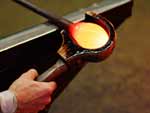 Most glass blowing is done on structures that have wall thicknesses substantial enough to allow shaping with tools. A wall as thin as .125" (3mm) can be shaped with blocks (spoon-shaped green cherry wood kept wet), jacks (stainless steel knife/scissor-looking tools) or wet newspaper held in one's hand—to name just a few. You can see some of them next to me on our gaffer's bench. These planet walls are so thin that touching them with anything will distort their shape or collapse them altogether; they must be free-blown as a final step.
Most glass blowing is done on structures that have wall thicknesses substantial enough to allow shaping with tools. A wall as thin as .125" (3mm) can be shaped with blocks (spoon-shaped green cherry wood kept wet), jacks (stainless steel knife/scissor-looking tools) or wet newspaper held in one's hand—to name just a few. You can see some of them next to me on our gaffer's bench. These planet walls are so thin that touching them with anything will distort their shape or collapse them altogether; they must be free-blown as a final step.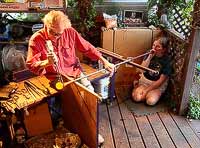 What makes the blowing out extra difficult is that there are differing thicknesses of different types of glass (all glasses are not the same because they are composed of varying elements to produce the colors). Different glass compounds heated to the same temperature will expand at different rates. They also accept heat differently. As you might imagine, since we cannot touch the expanding sphere to guide it into a spherical shape, this results in a substantial amount of eggs. Still, we have developed a method of producing a uniform sphere of "lumpy glass" without touching it. Took a LOT of practice.
What makes the blowing out extra difficult is that there are differing thicknesses of different types of glass (all glasses are not the same because they are composed of varying elements to produce the colors). Different glass compounds heated to the same temperature will expand at different rates. They also accept heat differently. As you might imagine, since we cannot touch the expanding sphere to guide it into a spherical shape, this results in a substantial amount of eggs. Still, we have developed a method of producing a uniform sphere of "lumpy glass" without touching it. Took a LOT of practice.
 We usually blow approximately ten candidates for each planet, choosing the overall best of each production to put into the sculpture. Some have great clouds but aren't spherical or, in the case of Saturn, the correct amount of oblateness but there is usually one that it all comes together and sings!
Blowing glass requires serious concentration. Talk about a demanding medium, glass is about as unforgiving as you can get. Dangerous, time consuming, requires a lot of practice, expensive to do—the materials, equipment and the energy costs are substantial—and it requires levels of planning and expertise that are just not encountered when doing work in two dimensions and certainly not when working with any digital program that has "Undo" and "Save As". Those of you who have followed me for a while know that I also work in both of those media, and more, so I'm not looking down my nose at them, by any means, but it's at least a magnitude more difficult; maybe two. Lose concentration, miss a step or get them out of order and you don't get to where you wanted to go. The process is so complex and exacting that a journal is kept of steps, formulae and general notes about how a particular work was done. It is modified as time goes by to add refinements if we discover some. Next time we need to make an Earth, for example, we have the previous sessions right there to refer to as if it were yesterday. Heck, we couldn't remember all of the steps and formulae if it were yesterday!
One may wonder why an artist chooses such a medium, but it is because of this degree of difficulty, and doing something that's never been done, that makes the work so exciting and satisfying. Disastrous when things go wrong, glorious when they go as planned, delightful when serendipity steps in (and it's good, that is). As we often say:
We usually blow approximately ten candidates for each planet, choosing the overall best of each production to put into the sculpture. Some have great clouds but aren't spherical or, in the case of Saturn, the correct amount of oblateness but there is usually one that it all comes together and sings!
Blowing glass requires serious concentration. Talk about a demanding medium, glass is about as unforgiving as you can get. Dangerous, time consuming, requires a lot of practice, expensive to do—the materials, equipment and the energy costs are substantial—and it requires levels of planning and expertise that are just not encountered when doing work in two dimensions and certainly not when working with any digital program that has "Undo" and "Save As". Those of you who have followed me for a while know that I also work in both of those media, and more, so I'm not looking down my nose at them, by any means, but it's at least a magnitude more difficult; maybe two. Lose concentration, miss a step or get them out of order and you don't get to where you wanted to go. The process is so complex and exacting that a journal is kept of steps, formulae and general notes about how a particular work was done. It is modified as time goes by to add refinements if we discover some. Next time we need to make an Earth, for example, we have the previous sessions right there to refer to as if it were yesterday. Heck, we couldn't remember all of the steps and formulae if it were yesterday!
One may wonder why an artist chooses such a medium, but it is because of this degree of difficulty, and doing something that's never been done, that makes the work so exciting and satisfying. Disastrous when things go wrong, glorious when they go as planned, delightful when serendipity steps in (and it's good, that is). As we often say:
“If it were easy, everyone would be doing it.”
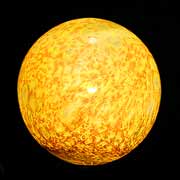 Once each is blown out to the target diameter, they go into the annealer for 8 or so hours to slowly cool from 950°F (510°C) down to ambient temperature. If this step is not taken or is not performed correctly, the glass builds up internal stress and shatters—if not immediately, soon. So, it isn't until morning that we know if we have successes that survived the cooling process. Some of our best don't and we're back in the hotshop the next day to duplicate it.... or try to. Putting glass in the annealer is sometimes fatal. Again, it's all about managing your heat. If the work goes into the annealer too cold and cracks during the "crack-off" process or it goes in too hot and suffers surface damage, you're starting over.
In the morning we look over the day's work, dust off the chalk, critique it, learn from new things we've tried and write the successes into the journal. When the selection has been made, the process known as "cold-working" begins. Using water-cooled saws, sanders and grinders, the extra bits and rough edges are taken off, smoothed and polished. Another opportunity for failure; sometimes spectacularly!
That'll be our topic for next time.
Got a question about our process or glassblowing in general? A horror story from your own shop to share, perhaps? Post a comment and let us know.
Once each is blown out to the target diameter, they go into the annealer for 8 or so hours to slowly cool from 950°F (510°C) down to ambient temperature. If this step is not taken or is not performed correctly, the glass builds up internal stress and shatters—if not immediately, soon. So, it isn't until morning that we know if we have successes that survived the cooling process. Some of our best don't and we're back in the hotshop the next day to duplicate it.... or try to. Putting glass in the annealer is sometimes fatal. Again, it's all about managing your heat. If the work goes into the annealer too cold and cracks during the "crack-off" process or it goes in too hot and suffers surface damage, you're starting over.
In the morning we look over the day's work, dust off the chalk, critique it, learn from new things we've tried and write the successes into the journal. When the selection has been made, the process known as "cold-working" begins. Using water-cooled saws, sanders and grinders, the extra bits and rough edges are taken off, smoothed and polished. Another opportunity for failure; sometimes spectacularly!
That'll be our topic for next time.
Got a question about our process or glassblowing in general? A horror story from your own shop to share, perhaps? Post a comment and let us know. Tags: art and science, astronomy, glassblowing, hot glass
Short URL for this post: //spherical.org/s/9

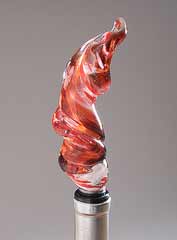
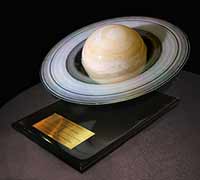
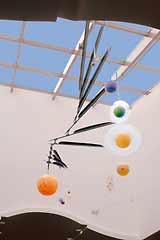
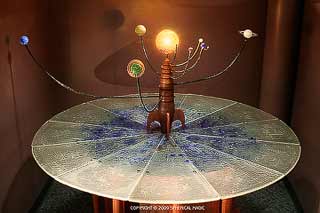
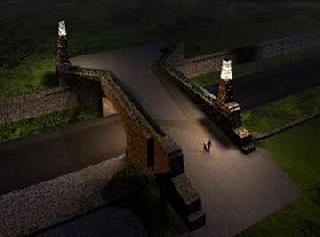
 RSS - Posts
RSS - Posts